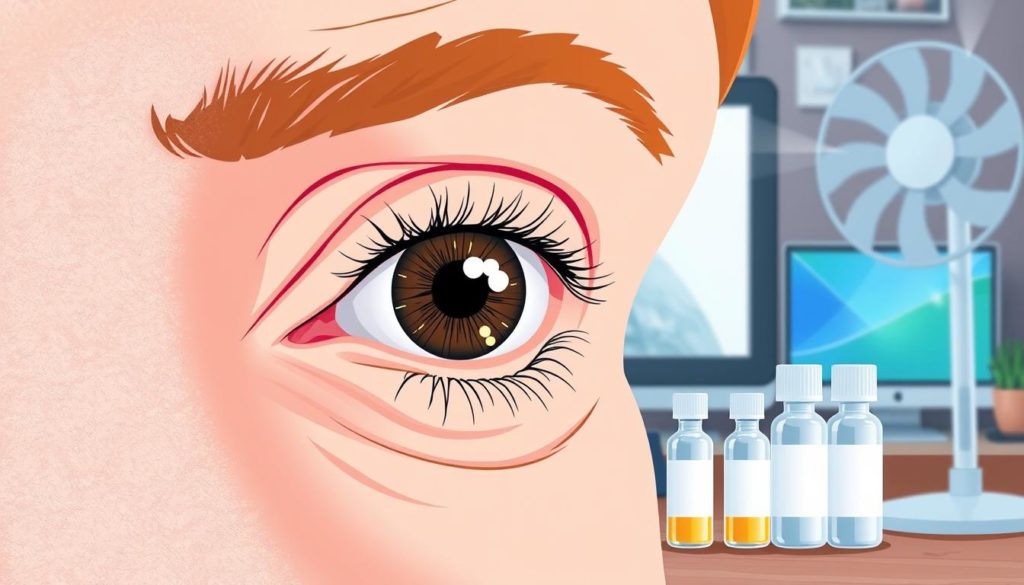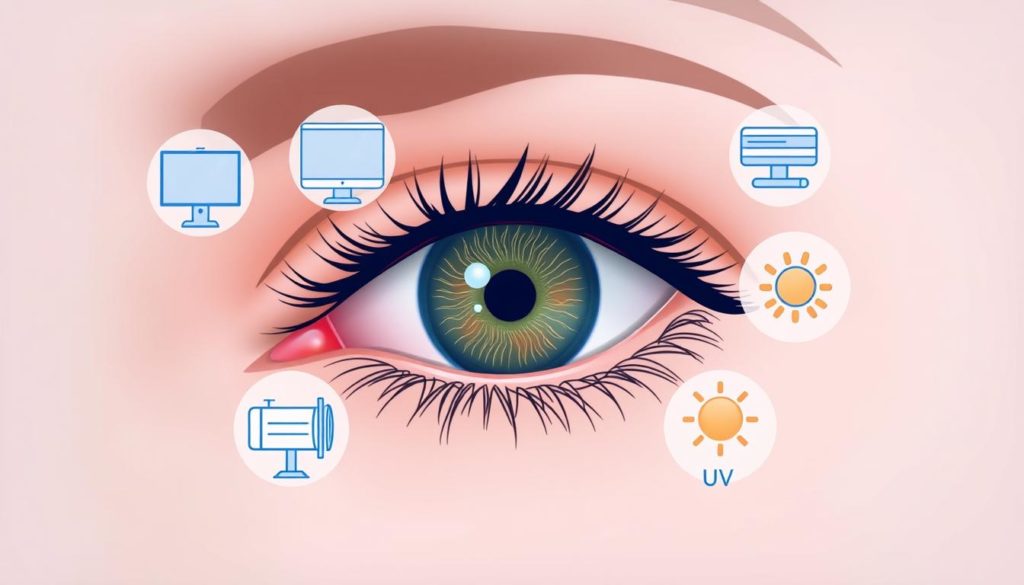About 16 million Americans deal with dry eye disease. This shows why it’s key to understand the causes and triggers. Issues like hormonal changes, autoimmune diseases, or environmental factors can worsen the discomfort. Knowing these causes aids in managing symptoms and avoiding eye problems.
Dry eye disease happens when your eyes don’t make enough quality tears. This leads to symptoms like burning or stinging. Being in places with air conditioning can also make it worse. It’s important to know what triggers dry eyes, such as wind or dry environments. Learning about these triggers helps us find ways to ease the discomfort and keep our eyes healthy.
What Are Dry Eyes?
Dry eyes happen when your eyes don’t get enough moisture from tears. This issue can make your eyes sting, burn, and even affect how well you see. Knowing why dry eyes happen is key to feeling better and stopping it from happening again.
Definition and Overview
Dry eye syndrome means your eyes don’t get enough tears to stay wet and healthy. Tears are important for a healthy eye surface and good vision. If your tears aren’t working right, you might end up with dry eyes.

Why Tears Are Essential
Tears are more than just water; they have oils, water, and mucus. They work together to clean, wet, and keep your eye’s front surface healthy. If this balance is upset, your eyes can get dry. It’s crucial to keep your tear film stable to avoid dry eyes.
Common Dry Eyes Causes
Understanding the reasons for dry eyes can help us manage and prevent discomfort. There are a few common causes we should know about.
Hormonal Changes
Hormonal changes, especially with aging or menopause, can affect tear production. This happens because hormones are key in keeping our bodies moist. This includes keeping our eyes well-lubricated.
Autoimmune Diseases
Autoimmune diseases, like Sjogren’s syndrome and rheumatoid arthritis, often lead to dry eyes. In these conditions, the immune system attacks moisture-producing glands. This attack reduces tear production and stability.
Environmental Factors
Environmental factors greatly contribute to dry eyes. Wind, smoke, or air conditioning can quickly dry out our eyes. These elements disrupt the moisture balance in our eyes, leading to irritation.

By understanding these common dry eyes causes, we can act to lessen their effects and keep our eyes healthy.
Decreased Tear Production
Decreased tear production, known as keratoconjunctivitis sicca, is a major cause of dry eye syndrome. It can be triggered by many medical issues, drugs, and nerve problems. These causes are often not recognized as related to dry eyes.
Medical Conditions
Some medical issues can lower tear production. Conditions like thyroid disorders, lupus, and aging can affect it. They make it hard for the body to make enough tears.
Medications
Many medications also trigger dry eyes by lowering tear production. Antihistamines and antidepressants especially are known for this. They make dry eye symptoms worse.
Nerve Desensitivity
Nerve desensitivity plays a big role too. Using contact lenses for a long time or having laser eye surgeries can numb the corneal nerves. This leads to less tear production, making dry eyes more uncomfortable.
Increased Tear Evaporation
Increased tear evaporation is a key reason for common dry eye causes. When tears evaporate faster than normal, your eyes can feel dry and uncomfortable.
Meibomian Gland Dysfunction
Meibomian gland dysfunction (MGD) greatly adds to increased tear evaporation. These glands make the oil for your tear film. This oil layer keeps eyes moist by stopping quick tear evaporation.
Without proper gland function, users face one of the common dry eye causes.
Eyecare and Contact Lens Usage
Poor eyecare and long contact lens wear can make things worse. They both can mess up your tear film. This leads to faster evaporation and dry eye symptoms.
To help, practice good hygiene and limit contact lens use. Doing so can ease some common dry eye causes.
Environmental Factors Causing Dry Eyes
Environmental factors are big reasons why people get dry eyes. Knowing what causes dry eyes helps us manage and prevent it.
Wind and Dry Air
Wind and dry air make tears evaporate faster, leading to dry eyes. This can happen outdoors on windy days or in dry, high places. WebMD says temperature and humidity changes also worsen dry eye symptoms.
Air Conditioning and Heating
Air conditioning and heating can dry out your eyes inside. They lower humidity, making dry eye issues worse. By using humidifiers and keeping air quality good, we can lessen these problems.
How to Identify Dry Eye Symptoms
It’s key to spot dry eyes symptoms early for good care and to avoid more issues. Knowing the signs aids in dry eye identification and ensures you get help from a doctor when needed.
Burning and Stinging Sensation
A clear sign of dry eyes is feeling a burn or sting in your eyes. This is often felt more after looking at screens for a long time or in bad weather.
Sensitivity to Light
Light sensitivity, or photophobia, is also a symptom. It makes bright places very uncomfortable. This sign is important for identifying dry eyes.
Redness and Irritation
Dry eyes usually cause red and irritated eyes. Eyes might look red and feel like there’s sand in them.
These dry eyes symptoms get worse in windy or smoky places, making the problem bigger.
Risk Factors for Developing Dry Eyes
Understanding the risk factors for dry eye syndrome can lead to better management and prevention. Age, gender, diet, and lifestyle choices are key. They greatly influence the risk of having dry eyes.
Age and Gender
As people hit 50, their tears production naturally goes down. This makes age a significant risk factor. Women face a higher risk due to hormonal changes. Pregnancy, menopause, and birth control pills affect them.
Dietary Habits
Your diet is vital for eye health. Not getting enough vitamin A and omega-3s can cause dry eyes. Eating fish, flaxseeds, and leafy greens can help fix this issue.
Lifestyle Choices
Certain lifestyle habits can increase your risk of dry eyes. Using contact lenses for a long time, having LASIK surgery, or being around cigarette smoke are major factors.
| Factor | Detail |
|---|---|
| Age | Individuals over 50 more susceptible |
| Gender | Women, due to hormonal changes |
| Diet | Low vitamin A and omega-3 intake |
| Lifestyle | Contact lenses, surgeries, cigarette smoke exposure |
Prevention Tips for Dry Eyes
Dealing with dry eyes can be tough. But, you can lessen symptoms and cut down on occurrences. Pay attention to your environment, care for your eyes properly, and live healthily. This way, you can keep dry eyes at bay.
Humidifiers and Wind Protection
One top tip for preventing dry eyes is to watch the humidity where you live and work. A humidifier keeps the air moist, helping your eyes stay comfortable. Also, when you’re outside, wear glasses or goggles. They protect your eyes from the wind and harsh environments, greatly lowering dryness risks.
Proper Eyecare Practices
Good eyecare habits are key. Remember to blink often, clean your eyelids and lashes well, and always use clean contacts. Taking breaks from looking at screens also helps. These steps can safeguard you from developing dry eyes.
Healthy Lifestyle Adaptations
Living healthily is vital for avoiding dry eyes. Eat foods high in vitamin A and omega-3s to help your eyes. Stay away from smoking and environments with cigarette smoke. These small changes can greatly help your eye’s health.
FAQ
What causes dry eyes?
Many things can cause dry eyes. Age, hormonal changes, and autoimmune diseases like Sjogren’s syndrome are a few. Environmental factors like wind and air conditioning also play a role.
What is dry eye syndrome?
Dry eye syndrome happens when your eyes don’t make enough tears or the tears are not good quality. This leads to problems like discomfort and blurry vision. If not treated, it can harm your eyes.
Why are tears essential for eye health?
Tears are vital for keeping the eye surface smooth and clear, which is essential for good vision. Tears have three layers – oils, water, and mucus. They help the eyes stay moist, prevent infection, and clean out dirt.
What common factors contribute to dry eyes?
Dry eyes can come from changes in hormones, autoimmune diseases, and environment like windy and dry conditions. Health issues like thyroid problems and lupus may also affect your tears.
How do hormonal changes cause dry eyes?
In women, changes in hormones during menopause or aging can lead to dry eyes. These changes can mess up the balance in tear layers and cause problems with lubrication.
What environmental factors can trigger dry eyes?
Wind, smoke, and air that is very dry can cause dry eyes. Also, air conditioning, heating, and being in places with low humidity like airplanes can make it worse. These factors make tears evaporate faster, causing discomfort.
How do medical conditions affect tear production?
Some health issues like thyroid disorders and lupus can decrease tear production. This leads to less tear volume and dry eyes.
Can medications cause dry eyes?
Yes, certain drugs like antihistamines, antidepressants, and medicines for blood pressure can make tears less or change their makeup. This can lead to dry eye issues.
How does nerve desensitivity relate to dry eyes?
Nerve desensitivity from long use of contact lenses or eye surgery can reduce the eye’s ability to feel dryness. This makes it hard to make enough tears, leading to dry eyes.
What is meibomian gland dysfunction?
This condition happens when the glands making the oily part of tears get blocked or don’t work right. It causes more tear evaporation and dry eyes.
Can contact lens usage contribute to dry eyes?
Yes, wearing contact lenses for a long time can mess up the tear film and reduce tear production. This leads to dry eyes.
How does wind and dry air affect tear evaporation?
Wind and dry air can make the tear film evaporate faster. This means tears disappear more quickly, causing dry eyes.
What role does air conditioning and heating play in dry eyes?
Air conditioning and heating can lower humidity, drying out the air indoors. This environment can make tear evaporation worse and cause dry eyes.
What are the common symptoms of dry eyes?
Typical signs include a burning or stinging in the eyes, light sensitivity, redness, and a gritty feeling. Eyes might water more too, as a response to irritation.
How do age and gender influence the risk of dry eyes?
People over 50 and women, especially during menopause, are more likely to get dry eyes. This is because of less tear production and hormonal changes.
How can dietary habits impact dry eyes?
Eating foods low in vitamin A and omega-3 fatty acids can make dry eyes worse. These nutrients are key for healthy tears and eye comfort.
What lifestyle choices can increase the risk of dry eyes?
Smoking, long contact lens wear, some eye surgeries, and being around smoke can up your risk of dry eyes. These habits affect tear production and quality.
What are some prevention tips for dry eyes?
To avoid dry eyes, use humidifiers for indoor moisture, wear glasses to block wind, and follow good eyecare habits. Eating well, with plenty of vitamin A and omega-3s, helps too.


